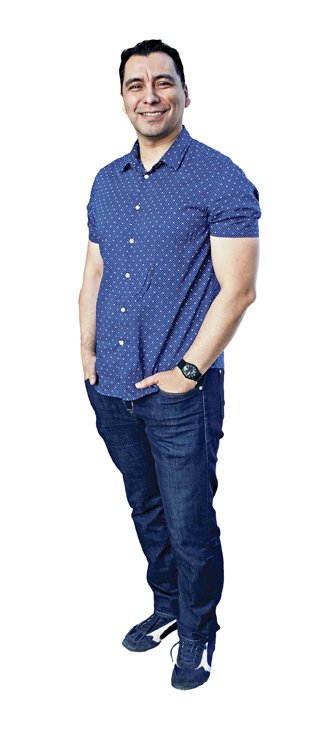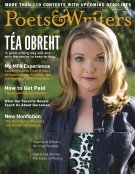This fall Manuel Muñoz will become the new director of the creative writing program at the University of Arizona in Tucson, succeeding writer Ander Monson. Established in 1972, the fully funded program recently switched to a three-year model and offers degrees in poetry, fiction, and creative nonfiction, as well as opportunities to work with small presses, literary journals, and arts organizations. With more than ten years of experience on the faculty, Muñoz has a clear vision of how to create a collaborative and inclusive community at the program, which counts Francisco Cantú, Jos Charles, Antonya Nelson, Alberto Ríos, Agha Shahid Ali, Richard Siken, and David Foster Wallace among its graduates. Muñoz received an MFA in creative writing from Cornell University and has published a novel, What You See in the Dark (Algonquin Books, 2011), and two story collections. A few months before the start of his position, Muñoz discussed his new role and offered advice for prospective students.

Manuel Muñoz (Credit: Patri Hadad)
What is an overlooked benefit of attending an MFA program?
Community connections—both within a supportive program and in the larger region in which it is situated—are crucial to how we shape ourselves as artists. Solitude at the desk is necessary, but collaboration is just as essential.
MFA programs have been criticized as spaces that are not safe or helpful for writers of color. How can programs create spaces that honor diversity of race and background?
In the past few years we’ve made strides in speaking about these issues as a program, rather than leaving it to the autonomy of the individual workshop. That’s the major difference between my MFA experience twenty years ago and the expectations now. As someone who is both queer and brown, I don’t know if safe is a word I will ever be comfortable using, but inclusivity, empathetic responsiveness, and deep engagement are all goals that we aim for. Every year a new cohort comes in, and it is our responsibility to set the expectations for the community we hope to create. This is hard work. Yet creating—and maintaining—spaces for all writers can’t always fall on faculty of color or queer professors or women. When it does, the resources need to be there. This year the directorship stipend was cut in half, which puts a damper on the pride of being one of the few writers of color to lead an MFA program. As more underrepresented groups enter the academy and assume administrative duties, university leadership will have to honor their stated goals in diversity hiring and retention efforts and commit the resources. Budgetary restrictions are real and dire at many universities, that’s true. But so is the importance of visibility when underrepresented writers see themselves reflected in leadership roles and that those faculty are respected by the institutions that ask them to do this work.
Why is full funding so important?
It alleviates some of the competitiveness or feelings of favoritism that can distract from the work. More important, it sends a strong message about a university’s values regarding literary activity and the place of writing, reading, and thinking in our larger culture. We need to find ways to ensure that students are not crushed by the staggering debt that is affecting this generation.
The University of Arizona program must be a big part of the Tucson literary community. Do you want the program to focus on nurturing writers from the region or do you want to bring in students from all over?
Both! Writers from the Southwest certainly see how important it is to delve into history, current events, and environmental studies, but curiosity leads all of us to explore. We see undergraduates go to the coasts, and we get applicants from all over the country who are drawn to the special nature of the desert. We’ve also seen a strong interest from international students, who see Arizona as a unique window into U.S. culture and life.
How does the program’s location impact the focus or social awareness of your students? Does the city of Tucson influence your students’ work?
It’s been important for the University of Arizona to acknowledge that it is located on the original homelands of the Indigenous peoples of this area. It dispels the notion that the university or even the city itself is the center—we’re not. For some writers, that appreciation does change the dynamic of their work. Whether it’s an interest in border politics or queer archives, they soon discover that they are stepping midstream into work already in progress. The awareness that one is a contributor, not an originator, is humbling and important.
There are a number of journals and presses affiliated with the university, as well as the Poetry Center and the Institute of the Environment and more. Why is it important to make these kinds of publications and spaces available to graduate students?
Our students learn a lot from seeing how writing is shepherded into the world: how journals are produced, how editorial work relies on curiosity and networking, and how creative projects can by “read” by the university as important engines for grant writing and research activity. The Poetry Center provides students with direct access to understanding how a national treasure promotes literary access and outreach. The fantastic panoply of literary journals—from Ander Monson’s superbly designed DIAGRAM to Kate Bernheimer’s deeply rich Fairy Tale Review—inspires not only editorial participation but an opportunity for students to benefit from the curatorial expertise of these faculty. The students are eager to act on their knowledge for their own projects and the results are inspiring: witness the online literary project Territory, which program alums Nick Greer and Thomas Mira y Lopez started a few years ago.
Any advice for MFA applicants?
In their artistic statements, many applicants comment on the time they need to write. That is certainly valuable, but our best writers have been the ones who can articulate how they are ready to transform and grow once they get here, rather than stick rigidly to their initial understandings. Can you take measure of all the resources available and find which will inspire a spirit of imagination and collaboration? Does a program provide a supportive atmosphere for you to experiment and try new things? One recent grad, Raquel Gutiérrez, came in with the poetry cohort, but has exited with “Brown Neon,” a nonfiction manuscript that has just been acquired by Coffee House Press. The project was informed by this terrain, by ongoing questions of artistic engagement, and by the urgent politics of the day. It’s a wonderful example of a writer who continues to work in one genre, but is inspired to read, explore, and create deeply in another.
What is a frequent mistake you see applicants making?
I see two missteps frequently. The first is assuming that you can only work with someone who is in close aesthetic alignment. I might be a “fuddy-duddy realist,” as I often call myself, but I read widely and with curiosity and engagement. I’ve worked with all manner of aesthetic approaches, and it’s fun to learn along with my students. All good faculty members are like this. They’re ready to help you in your development. They’re not seeking mirrors of themselves. Second, it’s easy to spot a statement that is written as what the applicant thinks we “might want to hear.” Authenticity comes from a writer’s genuine excitement in thinking about how they might proceed once they’ve considered place, resources, and faculty: They’ve got a plan and are not afraid to dream a little bit in their statements about why this particular program can make it come true.
Is there an element of the job of director of a creative writing program that gets overlooked?
Though I am new to the position, I can see the ongoing need to communicate how vital the creative arts are to the health and integrity of a university. There is always dialogue about how we create and keep space open for creative endeavor to be an integral part in what the university calls “research.” Creativity and the arts must always be part of a shared mission, especially as a land-grant university and a Hispanic-Serving Institution.
What are you excited about? What keeps you interested in the future of creative writing programs?
I get most excited when I can speak about how our creative writing program has always been part of innovative campus and community dialogues, from medical humanities to ecological awareness. Our students keep showing us new ways in which creative writing is a natural foundation to innovative thinking, advocacy, and leadership.
Jessica Kashiwabara is the senior web editor of Poets & Writers, Inc.









